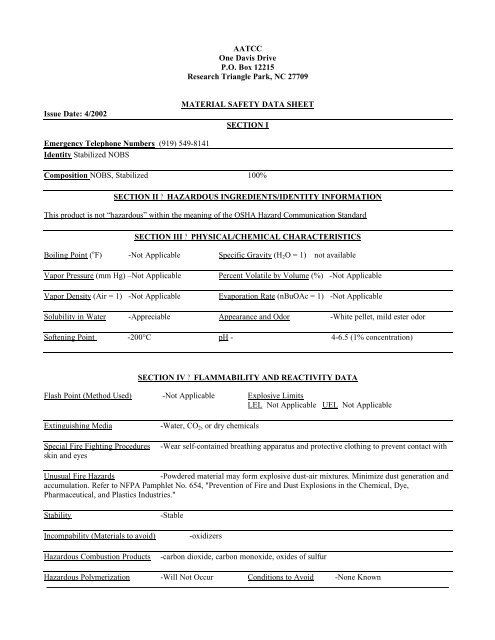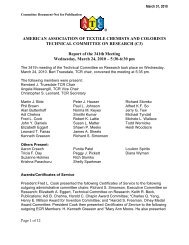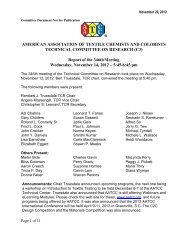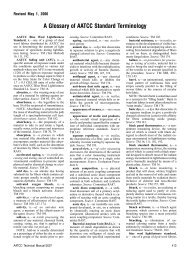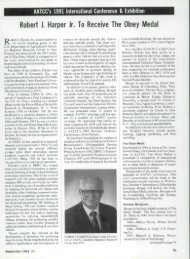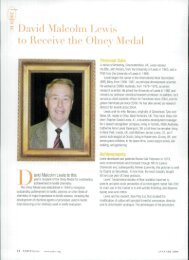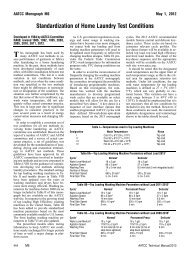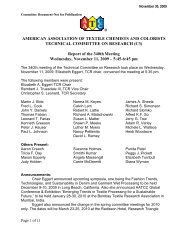Bleach Activator NOBS
Bleach Activator NOBS
Bleach Activator NOBS
You also want an ePaper? Increase the reach of your titles
YUMPU automatically turns print PDFs into web optimized ePapers that Google loves.
AATCC<br />
One Davis Drive<br />
P.O. Box 12215<br />
Research Triangle Park, NC 27709<br />
Issue Date: 4/2002<br />
MATERIAL SAFETY DATA SHEET<br />
SECTION I<br />
Emergency Telephone Numbers (919) 549-8141<br />
Identity Stabilized <strong>NOBS</strong><br />
Composition <strong>NOBS</strong>, Stabilized 100%<br />
SECTION II ? HAZARDOUS INGREDIENTS/IDENTITY INFORMATION<br />
This product is not “hazardous” within the meaning of the OSHA Hazard Communication Standard<br />
SECTION III ? PHYSICAL/CHEMICAL CHARACTERISTICS<br />
Boiling Point ( o F) -Not Applicable Specific Gravity (H 2 O = 1) not available<br />
Vapor Pressure (mm Hg) –Not Applicable<br />
Vapor Density (Air = 1) -Not Applicable<br />
Percent Volatile by Volume (%) -Not Applicable<br />
Evaporation Rate (nBuOAc = 1) -Not Applicable<br />
Solubility in Water -Appreciable Appearance and Odor -White pellet, mild ester odor<br />
Softening Point -200°C pH - 4-6.5 (1% concentration)<br />
SECTION IV ? FLAMMABILITY AND REACTIVITY DATA<br />
Flash Point (Method Used) -Not Applicable Explosive Limits<br />
LEL Not Applicable UEL Not Applicable<br />
Extinguishing Media<br />
Special Fire Fighting Procedures<br />
skin and eyes<br />
-Water, CO 2 , or dry chemicals<br />
-Wear self-contained breathing apparatus and protective clothing to prevent contact with<br />
Unusual Fire Hazards<br />
-Powdered material may form explosive dust-air mixtures. Minimize dust generation and<br />
accumulation. Refer to NFPA Pamphlet No. 654, "Prevention of Fire and Dust Explosions in the Chemical, Dye,<br />
Pharmaceutical, and Plastics Industries."<br />
Stability<br />
-Stable<br />
Incompability (Materials to avoid)<br />
Hazardous Combustion Products<br />
-oxidizers<br />
-carbon dioxide, carbon monoxide, oxides of sulfur<br />
Hazardous Polymerization -Will Not Occur Conditions to Avoid -None Known
SECTION V ? HEALTH AND SAFETY DATA<br />
Health Effects (Acute and Chronic)<br />
-Inhalation: Low hazard for usual industrial handling.<br />
-Eye: Low hazard for usual industrial handling. However, any material that contacts the eye may be<br />
irritating or may cause mechanical injury.<br />
-Skin: Low hazard for usual industrial handling.<br />
-Ingestion: Expected to be a low ingestion hazard.<br />
Emergency and First Aid Procedures<br />
-Inhalation: If symptomatic, remove to fresh air and get medical attention if symptoms persist.<br />
-Eye: Any material that contacts the eye should be washed out immediately and medical attention<br />
obtained if symptoms persist<br />
-Ingestion: Material is not expected to be absorbed from gastrointestinal tract so that induction of vomiting<br />
should not be necessary.<br />
-Skin: Wash with saop and water and get medical attention if symptoms occur.<br />
Other<br />
-None.<br />
SECTION VI ? PRECAUTIONS FOR SAFE HANDLING AND USE<br />
Precautions To Be Taken in Handling and Storing<br />
-keep from contact with oxidizing materials<br />
Other Precautions<br />
-None<br />
Steps To Be Taken In Case Material Is Released or Spilled<br />
-Collect and place in suitable container and dispose.<br />
Waste Disposal Method<br />
-Disposal is to be performed in compliance with all regulations.<br />
-Larger quantities of contaminated or waste material should be incinerated.<br />
SECTION VII ? SPECIAL PROTECTION INFORMATION<br />
Preventive Measures<br />
- None should be needed under anticipated conditions of use.<br />
Respiratory Protection (Specify Type)<br />
-An approved respirator should be worn if needed. Respirator type: dust.<br />
Ventilation<br />
-Good general ventilation (typically 10 air changes per hour) should be sufficient to control airborne levels.<br />
Ventilation rates should be matched to conditions. Supplementary local exhaust ventilation, closed systems, or respiratory<br />
protection may be needed in special circumstances such as poorly ventilated spaces, mechanical generation of dusts, heating,<br />
drying, etc.<br />
Eve Protection<br />
-Safety glasses with side shields (or goggles) are recommended for any type of industrial chemical handling.<br />
Protective Gloves<br />
-None required with normal use.<br />
-Protective gloves (rubber, neoprene) should be used for prolonged direct contact.
Other Protective Equipment<br />
-None necessary under normal use.<br />
Transportation Information<br />
-DOT (USA): Not regulated<br />
-TDG (Canada): Not regulated<br />
-Label Statements: POWDERED MATERIAL MAY FORM EXPLOSIVE DUST-AIR MIXTURES.<br />
Minimize dust generation and accumulation.<br />
The submission of this MSDS may be required by law but this is not an assertion that this substance is hazardous when used<br />
in accordance with proper safety practices and normal handling procedures. Data supplied is for use only in conjunction with<br />
occupational safety and health.


